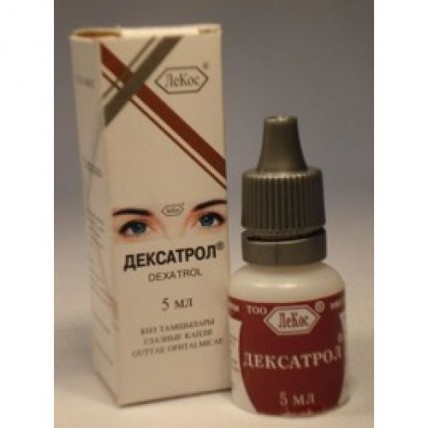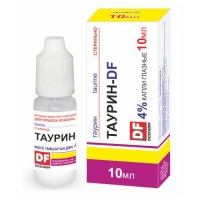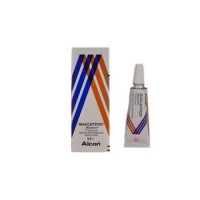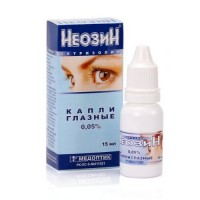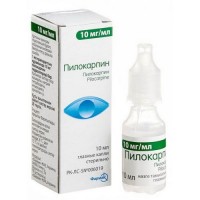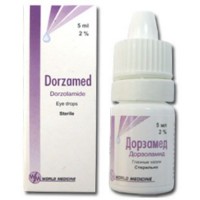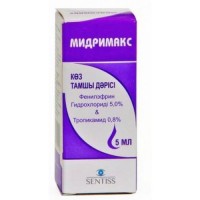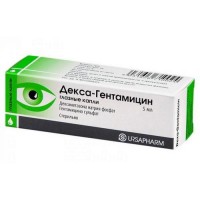The instruction for medical use of DEKSATROL® medicine Trade name ДЕКСАТРОЛ® the International unlicensed name Is not present the Dosage form Eye drops of 5 ml Structure 1 ml of solution contains active agents: Neomycinum sulfate of 5.00 mg of dexamethasone of sodium phosphate of 1.00 mg of polymyxin In sulfate of 6,000 PIECES, excipients: dihydrophosphate sodium a dihydrate and phosphate dinatrium dodecahydrate to rn 6.0 – 8.0, water for injections. Description Transparent colourless or yellowish liquid. Pharmacotherapeutic group Anti-inflammatory drugs in a combination with antimicrobial drugs. Glucocorticosteroids in a combination with antimicrobial drugs. Dexamethasone in a combination with antimicrobial drugs. The ATX S01CA01 code the Pharmacological Pharmacokinetics Dexamethasone properties is soaked up in watery moisture of an eye, a cornea, an iris of the eye, an eye choroid, a ciliary body and a retina. System absorption can arise only in case of use of high doses or at long treatment. The maximum concentration in watery moisture of an eye making about 30 ng/ml is reached within two hours which decreases during of half an hour till 3 o'clock subsequently. Neomycinum is practically not exposed to system absorption, it is found in therapeutic concentration in a cornea stroma, moisture of an anterior chamber and a vitreous within 6 hours. Sulfate polymyxin B absorption through cellular membranes lies in the range from very weak and insignificant before absolute not penetration. The pharmacodynamics the Combined drug Deksatrol® possesses antibacterial, anti-inflammatory and antiallergic action. Such optimum combination allows to reduce risk of development of infectious process and leads to prolongation of action of antibiotics. Sodium dexamethasone phosphate – the glucocorticosteroid, has no mineralokortikoidny activity. Renders the significant anti-inflammatory, antiallergic and immunodepressive effect. Oppresses emission by eosinophils of mediators of inflammation, migration of mast cells and reduces permeability of capillaries. The combination of Neomycinum of sulfate and polymyxin B of sulfate, being a part of the drug Deksatrol® eye drops, is active against the following species of pathogenic microorganisms: Gram-positive: Gram-negative Staphylococcus aureus Staphylococcus epidermidis: Escherichia coli Haemophilus influenzae of the Version Klebsiella/Enterobacter Proteus mirabilis Pseudomonas aeruginosa Serattia marcescens of Neomitsin sulfate and polymyxin In sulfate have synergy activity of in vitro against some strains of Enterococcus, including Enterococcus faecalis. Neomycinum sulfate – a bacterial antibiotic of a broad spectrum of activity. It is active concerning the majority of gram-positive and gram-negative microorganisms and has low risk of selective microbic stability. However, the majority of Streptococci and a set of strains of Pseudomonas are resistant to Neomycinum. Polymyxin In sulfate – selection antibacterial agent, is mainly active against gram-negative microorganisms, including Pseudomonas aeruginosa. Дексатрол® eye drops does not provide full protection against Streptococci, including Streptococcus pneumonia. Indications the Inflammatory conditions of an eye which are followed by a superficial bacterial infection or with risk of a bacterial infection, responding to treatment by corticosteroids such, as: - inflammatory conditions of a conjunctiva of a century or an eyeball - inflammation of a cornea and front piece of an eye - a chronic uveitis of a front piece of an eye - defeat of a cornea chemicals, radiation, thermal burns or a foreign body the Route of administration and doses Before appointment to the patient of the drug Deksatrol® is desirable to define susceptibility to it of the microflora which caused a disease in this patient. At not heavy infectious process 1-2 drops of drug in a conjunctival sac of the affected eye (eyes) dig in 4-6 times a day. It is necessary to reduce gradually use frequency in process of improvement of clinical signs. It is not recommended to stop treatment prematurely. In case of development of heavy infectious process, drug is dug in on 1-2 drops each hour with gradual reduction of frequency in process of disappearance of signs of inflammation before complete cessation of use of drug. The course of treatment is defined by the attending physician. After burying the pressing of the lacrimonasal channel or cover is recommended a century. It reduces system absorption and an adverse effect of the medicine which is applied locally through eye tissues. When using several ophthalmologic drugs, it is necessary to observe an interval between burying of about 10-15 minutes. It is necessary to watch that the tip of a bottle dropper did not contact to an eye and other objects and surfaces. After burying the bottle dropper is densely closed a cap. Side effects Often - irritation of an eye - discomfort in an eye (burning, acute prickings, an itching) Infrequently (at prolonged use) – increase in intraocular pressure with possible subsequent development of glaucoma and, in isolated cases, with injury of an optic nerve and fields of vision, deterioration in visual acuity, – a back subkapsulyarny cataract, System is frequent: - hypersensitivity It is unknown: - the headache the Frequency and gravity of the following side reactions cannot be determined by the reason of insufficiency of data. Local: an ulcer keratitis, thinning of a cornea, a photophobia, illegibility of sight, a mydriasis, eye pain, an itching of an eye, eye hypostasis, a ptosis, omission of a century, feeling of a foreign body in an eye, increase in dacryagogue, eye hyperaemia. Contraindications – hypersensitivity to drug and its components, – viral diseases of eyes (including the keratitis caused by herpes simplex, chicken pox), – the mikobakterialny infections of eyes caused, but not limited by the following acid resisting mycobacteria: Mycobacterium tuberculosis, Mycobacterium leprae or Mycobacterium avium, - fungus diseases of structures of an eye – the purulent infection of a mucous membrane of an eye and a century caused by microorganisms, resistant to action of Neomycinum, a purulent helcoma, Medicinal interactions As system absorption of active ingredients low risk of emergence of undesirable effects is minimum. Combined and/or consecutive use of aminoglycoside (Neomycinum) and others system, peroral or topical administration of the medicines having neurotoxic, ototoksichesky or nephrotoxic effects can result in additive toxicity and, whenever possible, has to be excluded. Special instructions Only for local ophthalmologic use. Not intended for injections or intake. As well as in a case with other antibacterial drugs the prolonged use can lead to the overgrowth of insensitive bacterial strains or mushrooms. In case of development of superinfection it is necessary to begin the corresponding treatment. During use of drug the hypersensitivity to aminoglycosides of topical administration and also cross sensitivity to other aminoglycosides can be observed. In case of serious reactions of hypersensitivity it is necessary to stop drug use. It is necessary to see a doctor in case of steady manifestation or strengthening of pain in an eye, redness, puffiness, irritation during use of the drugs containing Neomycinum sulfate. It is necessary to consider a possibility of cumulative toxicity when using Deksatrol® medicine eye drops together with system aminoglycosides or polymyxin B. Long use or increase in frequency rate of use of drug can lead to eye hypertensia and/or development of glaucoma with the subsequent injury of an optical optic nerve, to decrease in visual acuity, disturbance of a field of vision and also formation of a back subkapsulyarny cataract. At the patients inclined to the listed states, increase in intraocular pressure can be observed even after the short period of use of drug. At use of drug for patients with glaucoma, treatment should not exceed two weeks, in the absence of reasonable need of more long-term treatment, to patients, is long applying corticosteroids locally in eyes, it is recommended to control intraocular pressure constantly. Corticosteroids can reduce resistance to a bacterial, viral or fungal infection and also contribute to their development, can mask clinical signs of infection, complicating timely detection of inefficiency of an antibiotic or to suppress reactions of hypersensitivity to drug components. At patients with the steady keratohelcosis accepting or accepting corticosteroids the probability of presence of a fungal infection is not excluded. In case of confirmation of a fungal infection the treatment by corticosteroids has to be stopped. At topical administration of corticosteroids in the diseases causing thinning of a cornea or sclera their perforation is possible. The corticosteroids applied locally in eyes can slow down healing of corneal wounds. Use for patients with a renal and liver failure of Researches was not carried out. However, owing to low system absorption of active components at topical administration, correction of a dosage it is not required. With care appoint in glaucoma, a cataract. When using drug within 10 days and more, monitoring of intraocular pressure is necessary. In case of glaucoma, intraocular pressure has to be checked weekly. Use in pediatric practice is not recommended use for children. Pregnancy and the period of a lactation Data on medicine use by pregnant women either are absent, or are provided in limited volume. During pregnancy the use is not recommended. There are no reliable data about whether active components of drug after topical ophthalmologic administration get into breast milk. The decision on whether it is necessary to refrain from breastfeeding or to interrupt therapy with eye drops, it is necessary to accept, considering advantage of breastfeeding for the child and advantage of medicine for mother. Contact lenses Carrying contact lenses is not recommended during treatment of infections of an eye. It is recommended to refrain from carrying contact lenses during treatment. Features of influence of medicine on ability to run the vehicle or potentially dangerous mechanisms If at the patient after drug use the sight clearness temporarily decreases, then before its restoration it is not recommended to drive the car and to be engaged in other activity demanding high concentration of attention and speed of psychomotor reactions. Overdose cases of overdose are not known. Overdose symptoms the drug Deksatrol® eye drops can be similar to some signs of undesirable reactions, such as: dot keratitis, erythema, increase in dacryagogue, Eden and naggers of a century. Treatment: has to be symptomatic and supporting, it is necessary to wash out eyes/a eyes plentiful amount of warm water. A form of release and packing On 5 ml in bottles droppers polyethylene, hermetically corked by the screwing-up covers with control of the first opening. On 1 bottle together with the instruction for medical use in the state and Russian languages place in a pack from cardboard. To Store storage conditions at a temperature from 15 wasps up to 25 wasps, in the place protected from light. To store out of children's reach. Prescription status According to the prescription. A period of storage 3 years a drug Period of storage after opening of a bottle - 4 weeks. Not to apply after the expiration date specified on packing. LeKos LLP producer 050000, Almaty, Kabangbai St. of the batyr, 114-13, ph.: 308-10-67. Owner of the registration certificate of LeKos LLP, Republic of Kazakhstan 050000, Almaty, st. Batyr's Kabangbai, 114-13. The address of the organization accepting in the territory of the Republic of Kazakhstan claims from consumers on quality of products 050000, Almaty, Kabangbai St. of the batyr, 114-13, ph.: 308-10-67. e-mail: lecos1@mail.ru, www.lecos.kz Address of the organization responsible for post-registration observation of safety of medicine of LeKos LLP, Republic of Kazakhstan 050000, Almaty, Kabangbai St. of the batyr, 114-13, ph.: 308-10-67. e-mail: lecos1@mail.ru, www.lecos.kz
to Develop
to Develop
